By Terry Foxx
Among the changing months, May stands confessed
The sweetest and in fairest colors dressed!
– James Thomson, Scottish poet (1700-48)
When we think of May, there are celebrations, fun facts, and folklore. May has become a bridge between spring and summer. Butterflies, bees, ladybugs, and hummingbirds help us enjoy the new life emerging from the earth. April has brought forth daffodils, forsythia, and hyacinths in our gardens, but May brings forth many wild plants to enjoy.
So what are some of the holidays of May? First there is Cinco de Mayo (May 5th), which celebrates the victory of the Mexican Army over the French in 1862 (Battle of Puebla). Then comes Mother’s Day (May 8th). Remember your mother on that day and celebrate! And of course May 30th, we remember those who have gone before us, especially veterans. Some families traditionally decorate graves of ancestors.
And of course there are other days to celebrate. How about Root Canal Awareness week (May 4th-11th) or Dance like a Chicken Day (May 14th). On May 8th you can officially wear no socks because it is a No Socks Day! And on May 15th step outside and view the full moon, a full flower moon! A snowstorm in May is said to be worth a wagon load of hay!
May birthdays are also special. In our family there are two special birthdays: one May 15th and the other May 23rd. May was also important to botanists and biologists! On May 23, 1707, Swedish botanist and naturalist Carl Linnaeus was born, and his legacy is important to every botanist and ecologist. (I doubt my grandson realized he was in good company). He became important in history for a system of classifying and naming organisms according to genus and species. We call it binomial nomenclature. Linneaus used Latin to identify various plants and animals, and in doing so often describes some important aspect of the organism. For example, humans are classified as Homo sapiens. Homo means “man” and sapiens means “wise”. Today, DNA and genetics are changing some names and relationships, but new names still follow the binomial nomenclature system of naming genus and species.
May is also a time that the world begins to dress itself in colors of red, blue, purple, white, and yellow. The calendar declares that spring begins March 20th, but in April we see deciduous trees and shrubs leafing out and the world becoming alive again after the cold of winter. Daffodils grace yards with the symbolic message of new beginnings and rebirth. We excitedly exclaim, “Spring is here.”
Colors of May
I became curious about the colors of May. Early in April, yellow daffodils and purple hyacinths burst forth, and that signals spring.
Here is what I did. I decided to search through the three volumes of Plants of the Jemez Mountains that Craig Martin and I finished. I wrote down the scientific name, common name, those that bloom from March to the end of May, and color of each plant. You can see some of the results in Table 1.
There was no simple answer as to what the dominant color of the season would be. Each of us has our own idea of color. A purple flower may look purple to some, but lavender to others. Some may say a flower is pink, and others red. So I tried to solve this by putting it into the scheme of colors: white (it can range from dirty white to cream), yellow (pale yellow to bright yellow), purple (from lavender or violet to dark purple), red (from red to rose), blue (including blue purple) and orange. Green flowers were often inconspicuous, as were brown.
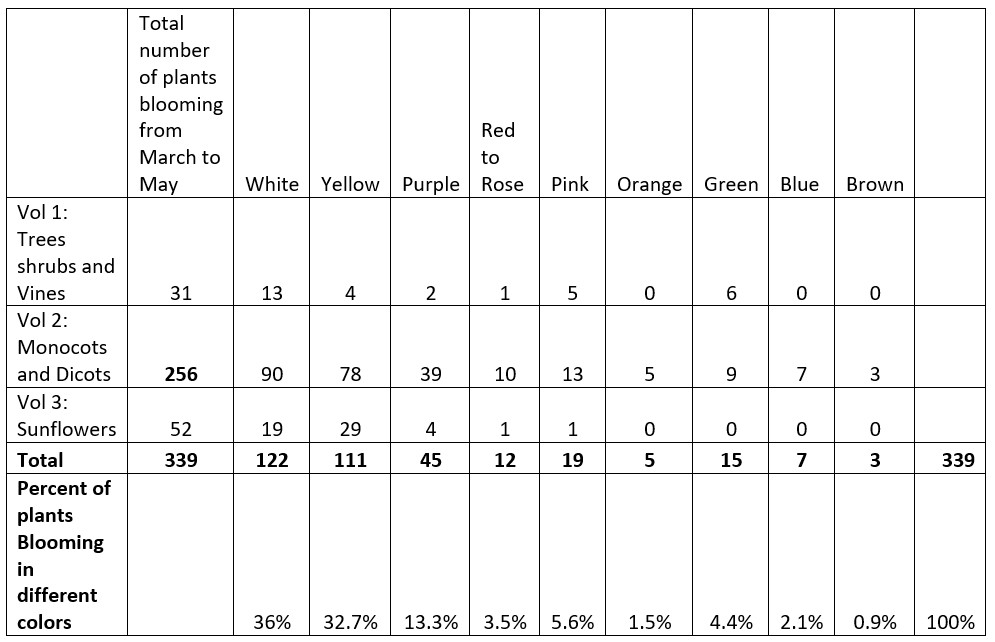
Did you know that there are two colors that seem to be relatively rare in our area: blue and orange? There are only seven species of blue flowers in the Jemez Mountains. Look for the blue flax, (Linum lewisii) often found as a roadside plant with its powder blue petals and slender stem. The orange species are primarily in the mallow family as globemallow (Sphaeralcea spp.). Five species, including the Butterfly Flower, are found in our book.
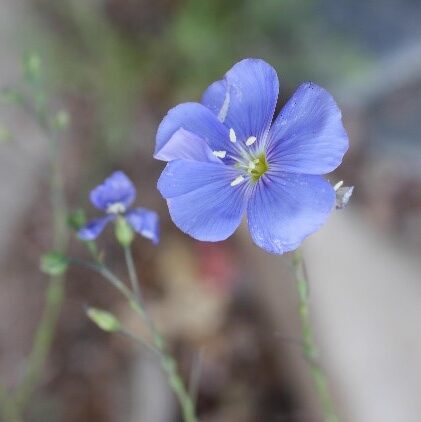
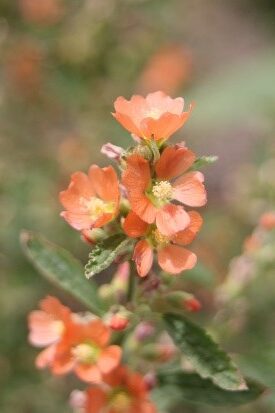
White flowers were the dominant color, followed by yellow and, finally, purple. It surprised me that yellow flowers were the most dominate amongst the Composite (Vol. 3), especially in May. I guess it shouldn’t be a surprise, because many Composites are yellow. Another thing l learned from this exercise is that over 50% of the flowers in our books about the Jemez Mountains, bloom by the end of May! So get out and hike and let us know what you find!
Organisms and Flower Colors
As the earth renews itself, butterflies, bees, and hummingbirds begin to visit our gardens and the wild earth. I wondered if these organisms had favorite flower colors.
Interestingly, Science.org wondered the same thing about bees. In October of 2017, they wrote an article indicating that bees prefer flowers in the violet blue range because they have high volumes of nectar. Other articles (see references cited below) indicate that butterflies really like plants that can hold their weight, often flat-topped. They prefer colorful and sweet-smelling flowers. Bright flowers in the range of pink and purple supposedly are their favorite. An important butterfly flower is Butterfly Milkweed (Asclepias tuberosa, orange), especially to the Monarch Butterfly.
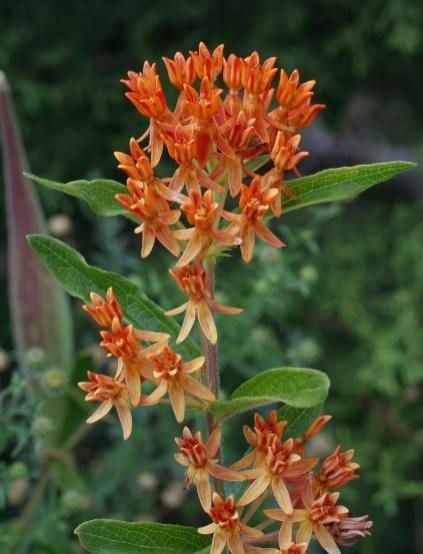
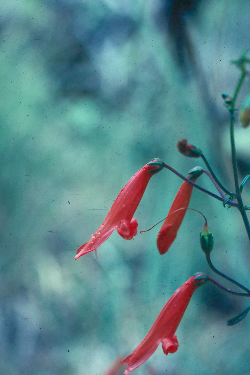
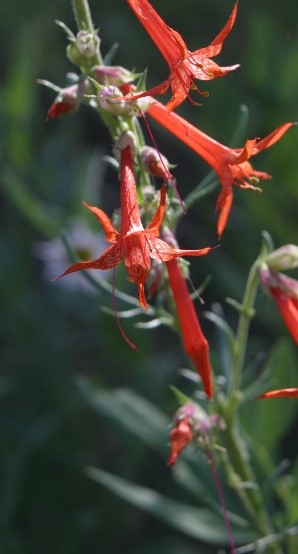
Hummingbirds like brightly colored blooms. Red is one of their favorite hues, especially if the flower is tubular. Skyrocket (Ipomopsis aggregata) is often called a hummingbird flower by Native Americans because hummingbirds are often seen around them. Tubular flowers accommodate their long beaks, which are helpful in getting the nectar. However, hummingbirds also like nodding flowers, which bend downward and make it easier for hovering hummingbirds to drink the nectar. Look for hummingbirds around the red penstemons as they begin to bloom around the Nature Center!
So, if white and yellow flowers are so prominent what animal likes them best? The ladybug or beetle wins. There are lots of destructive bugs on plants: aphids, mites, scale insects. However, a ladybug (beetle) is a much-loved insect eating creature. They supposedly bring good fortune and good luck to your garden. Most of us love the shiny white or black spotted red body of the ladybug. A favorite nursery rhyme begins as a ladybug sits on our finger “Ladybug, Ladybug fly away home…”. Beyond our fascination with these little creatures, ladybugs eat aphids, mites, scale insects, and pollen, helping to save those yellow and white flowers from destruction.
Plants of Spring
In our area there are two plants I look for in the spring, the Pasque flower, and the Easter Daisy. Recently, Jim Cobble found the stately Pasque flower along the Burnt Mesa Trailhead. Both flowers begin to boom in April but can extend into May. Pasque is a French word meaning Easter. What an exciting find! Look for the Easter Daisy in the open areas of the Pinon-Juniper woodland in the White Rock area.
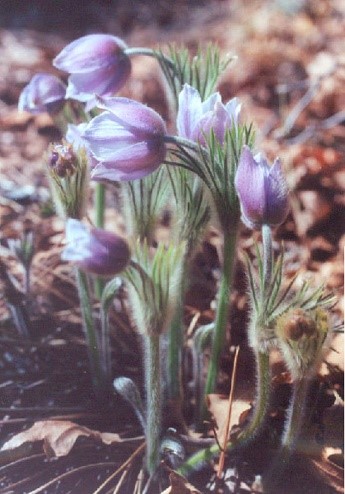
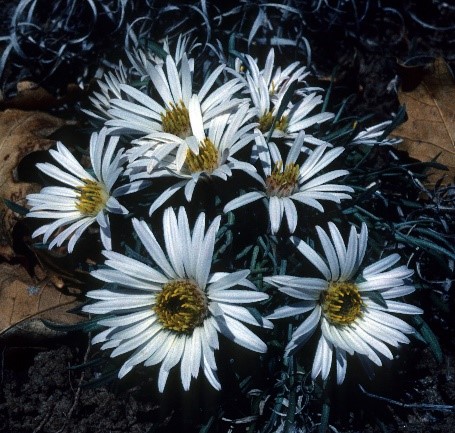
An Exercise…
Here is a fun exercise. Go to a store that sells paint and get some paint chips. Take them along on a hike and compare the chips with the colors of flowers. You will learn a lot about the flowers and their colors. Report what you find on the interest group “PEEC Wild Plants” or “Let’s Journal”! You can subscribe to these groups here.
References
“Why Flowers Have Color,” Konica Minolta. https://sensing.konicaminolta.us/us/blog/why-flowers-have-color/. (accessed 5 May 2022)
Allman, Molly. “The Color of Flowers That Attract Hummingbirds”. SF Gate. https://homeguides.sfgate.com/color-flowers-attract-hummingbirds-48562.html. (accessed 5 May 2022)
“The Month of May 2022: Holidays, Fun Facts, Folklore,” Almanac. https://www.almanac.com/content/month-may-holidays-fun-facts-folklore. (accessed 5 May 2022)
Degnan, Sasha. “Butterfly-Pollinated Flowers”. SF Gate. https://homeguides.sfgate.com/butterflypollinated-flowers-25707.html. (accessed 5 May 2022)
Foxx, Teralene, Craig Martin, Dorthy Hoard, Plants of the Jemez Mountains, 3 Volumes.
Morell, Virginia. “Flower Petals Have ‘Blue Halos’ to Attract Bees.” Science.org. https://www.science.org/content/article/flower-petals-have-blue-halos-attract-bees. (accessed 5 May 2022)
“Ladybug”. National Geographic Kids. https://kids.nationalgeographic.com/animals/invertebrates/facts/ladybug. (accessed 5 May 2022)
